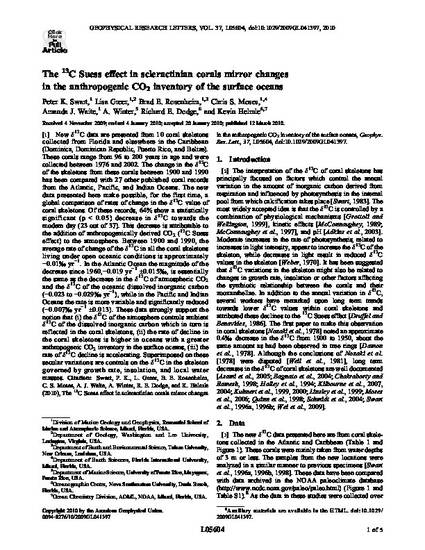
- Carbon cycling,
- Isotopic composition and chemistry,
- Marine systems,
- Paleoclimatology and paleoceanography
New δ13C data are presented from 10 coral skeletons collected from Florida and elsewhere in the Caribbean (Dominica, Dominican Republic, Puerto Rico, and Belize). These corals range from 96 to 200 years in age and were collected between 1976 and 2002. The change in the δ13C of the skeletons from these corals between 1900 and 1990 has been compared with 27 other published coral records from the Atlantic, Pacific, and Indian Oceans. The new data presented here make possible, for the first time, a global comparison of rates of change in the δ13C value of coral skeletons. Of these records, 64% show a statistically significant (p < 0.05) decrease in δ13C towards the modern day (23 out of 37). This decrease is attributable to the addition of anthropogenically derived CO2 (13C Suess effect) to the atmosphere. Between 1900 and 1990, the average rate of change of the δ13C in all the coral skeletons living under open oceanic conditions is approximately −0.01‰ yr−1. In the Atlantic Ocean the magnitude of the decrease since 1960,−0.019 yr−1 ±0.015‰, is essentially the same as the decrease in the δ13C of atmospheric CO2 and the δ13C of the oceanic dissolved inorganic carbon (−0.023 to −0.029‰ yr−1), while in the Pacific and Indian Oceans the rate is more variable and significantly reduced (−0.007‰ yr−1 ±0.013). These data strongly support the notion that (i) the δ13C of the atmosphere controls ambient δ13C of the dissolved inorganic carbon which in turn is reflected in the coral skeletons, (ii) the rate of decline in the coral skeletons is higher in oceans with a greater anthropogenic CO2inventory in the surface oceans, (iii) the rate of δ13C decline is accelerating. Superimposed on these secular variations are controls on theδ13C in the skeleton governed by growth rate, insolation, and local water masses.

©2010 by the American Geophysical Union